Each programming language provides a method for adding comments to one or more lines of code. Comments play a crucial role in programming with Python because they help make the code easier to read and maintain.
To comment out multiple lines in Python, you can use triple quotes (”’ ”’ or “”” “””) for block comments, or add a hash sign (#) at the beginning of each line for single-line comments.
When you add explanations for tricky parts or offer context for particular functions, it becomes much simpler for other developers to understand what’s going on.
Additionally, comments serve as a handy form of documentation, which means that new team members or future programmers can get up to speed quickly without having to spend ages figuring out the code. In short, by using comments, you’ll make the whole development process smoother and ensure that your code remains user-friendly, easy to maintain, and adaptable as time goes on.

Before we dive into the details of multi-line commenting in Python, let’s first understand what single-line and multi-line comments are.
What are Multi-Line and Single-Line Comments in Python?
Single-line comments: Single-line comments begin with a hash symbol (#) and extend to the end of the line. The Python interpreter ignores everything that comes after the hash symbol (#) on that line. The comments are generally used for brief explanations or notes about the code.
The following is an example of a single-line comment:
Multiple line comments: Multiple line comments, also known as multi-line comments or block comments, are a way to comment out a block of code or add descriptive text spanning multiple lines in Python.
While Python does not have a specific syntax for multiline comments, developers use triple quotes (either single (”’ ”’) or double (“”” “””)) to create multiline strings, which the interpreter ignores during execution.
This technique effectively serves as a multi-line comment.
The following is an example of a multiline comment in Python:
Fortunately, there are a few different ways to comment out a multi-line comment in Python, depending on your text editor or IDE (Integrated Development Environment). Here’s what you need to know.
One common way to comment out multi-line comments in Python is to use the hash symbol (#) to comment out each line individually. This approach can be time-consuming if you have many lines of code to comment out, but it works in any text editor or IDE.
Another option is to use a keyboard shortcut to comment on multiple lines at once. This can be faster and more convenient, especially if you need to comment out large sections of code.
Let’s discuss in detail how to use the hash symbol and keyboard shortcut to make multiline comments in Python!
How to Use The # Symbol to Make Multi-Line Comments
As mentioned, if you want to comment out multiple lines in Python, you can use the # symbol to turn them into single-line comments. Simply place a hash character (#) at the beginning of each line you want to comment out. This will tell Python to ignore those lines when it runs your code.
The following is an example of how to comment out multiple single-line comments in Python using the hash character(#):
Understanding how to comment out multiple lines in Python can significantly improve your programming experience.
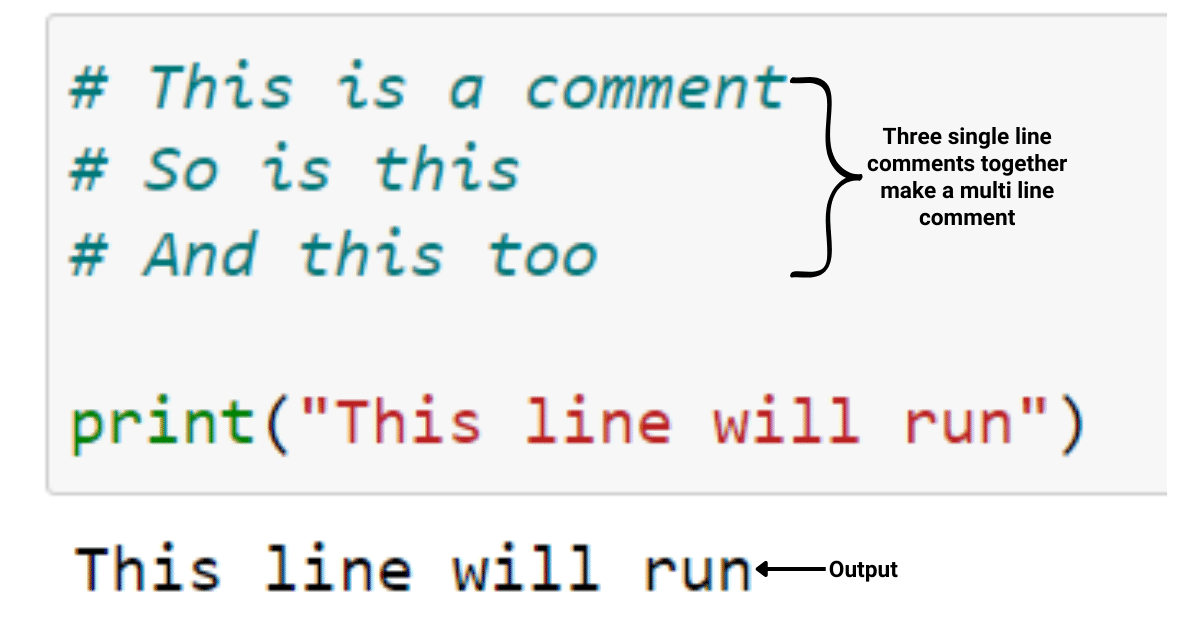
In the given example, the first three lines are commented out using single-line comments by placing the # symbol at the beginning of each line. When executing this Python code, the interpreter ignores these lines and only runs the print statement.
However, using consecutive single-line comments can be tedious when dealing with numerous lines. For such cases, utilizing multi-line comments or employing a text editor or IDE with a shortcut for commenting out multiple lines at once is advisable.
In the section below, we will run through how to comment out multiple lines in Python using Triple quoted strings.
Let’s get into it!
How to use Triple Quotes to Comment Out Multiple Lines
Multiline comments are enclosed in triple quotes, either single (”’ ”’) or double (“”” “””), creating a multiline string that Python disregards. This approach effectively comments out multiple lines and makes it easier to manage extensive sections of code that require temporary disabling or explanations. This method is especially useful when you have to comment out code that already contains single-line comments.
To comment out multiple lines of code in Python using Triple quotes, you can follow the steps below:
Start with three quotes: “””
Add a newline character (n) to start a new line and add a hash symbol (#) to comment out the line of code.
Repeat step 2 for each line of code you want to comment out.
End with three quotes: “””
The following example shows how to use triple quotes to comment out text that spans multiple lines:
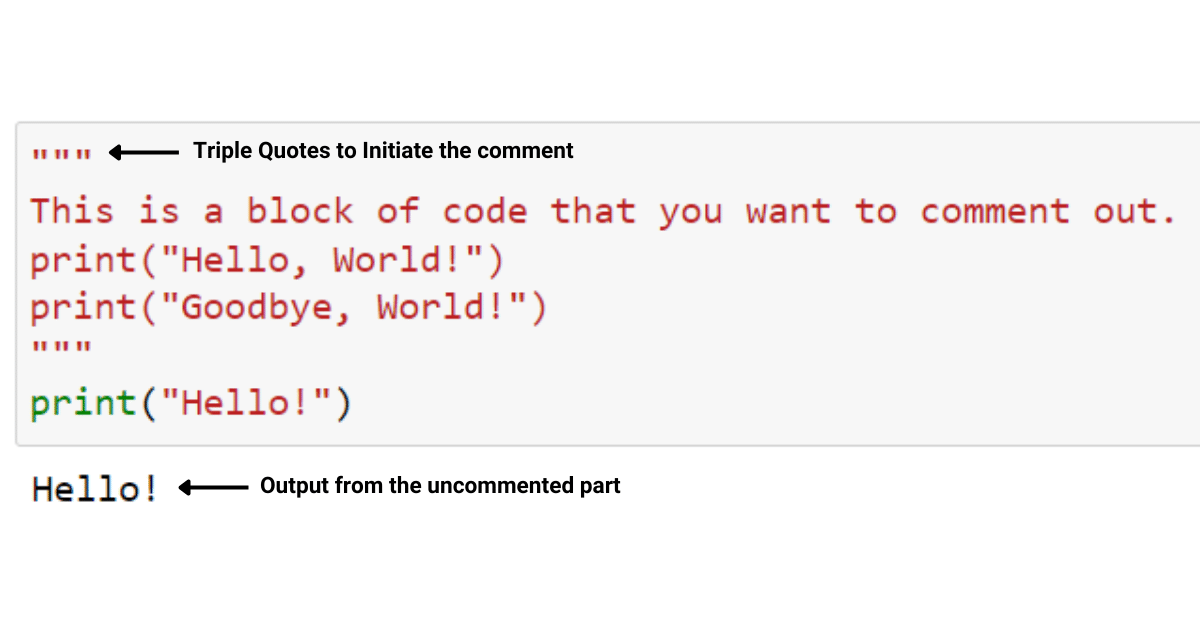
When executing the above code with a multiline comment enclosed in triple quotes, no action will occur because the entire block of code is considered a multiline comment or multiline string, and the interpreter ignores it.
To uncomment the code, remove the triple quotes surrounding the block. It’s crucial to remember that using triple quotes for multiline comments or multiline strings can impact your code’s indentation. Always ensure you adjust the indentation accordingly to maintain readability and avoid errors in your code.
Overall, employing triple quotes for multi-line comments or multi-line strings to comment out multiple lines in Python is a convenient and efficient technique, saving time and effort. Whether you’re working with a singleline comment , consecutive singleline comments, or multiline comments, understanding how to comment out multiple lines in Python is essential for better code management.
Apart from the above two ways of commenting on multiple lines in Python, you can comment out lines using keyboard shortcuts within IDEs as well. In the section below, we’ll have a detailed discussion on how to comment out multiple lines using IDE’s with keyboard shortcuts.
Let’s get into it!
How to Use Shortcuts in IDE to Comment Out Multiple Lines
An Integrated Development Environment is a software application that offers a comprehensive set of tools and features to help programmers write, edit, debug, and compile code more efficiently.
Different IDE’s come with their own specified shortcuts that you can use to automatically comment out multiple lines of code in Python.
In this section, we will have a detailed look at how to comment out multiple lines of code in three of the most popular Integrated Development Environments; The VS Code, PyCharm and Sublime Text.
Let’s look into it!
How to Comment Out Multiple Lines in Visual Studio Code
Visual Studio Code, commonly referred to as VS Code, is a free, open-source, and lightweight source code editor developed by Microsoft. It is designed to work with multiple programming languages, including Python, JavaScript, C++, and many others.
VS Code offers a range of features such as syntax highlighting, code completion, debugging, integrated terminal, version control, and support for extensions. Due to its flexibility, performance, and extensive features, VS Code has become a popular choice among developers worldwide for various programming tasks.
Visual Studio Code is a popular code editor that supports commenting out multiple lines of code.
Here’s how to use it:
Select the lines of code you want to comment out.
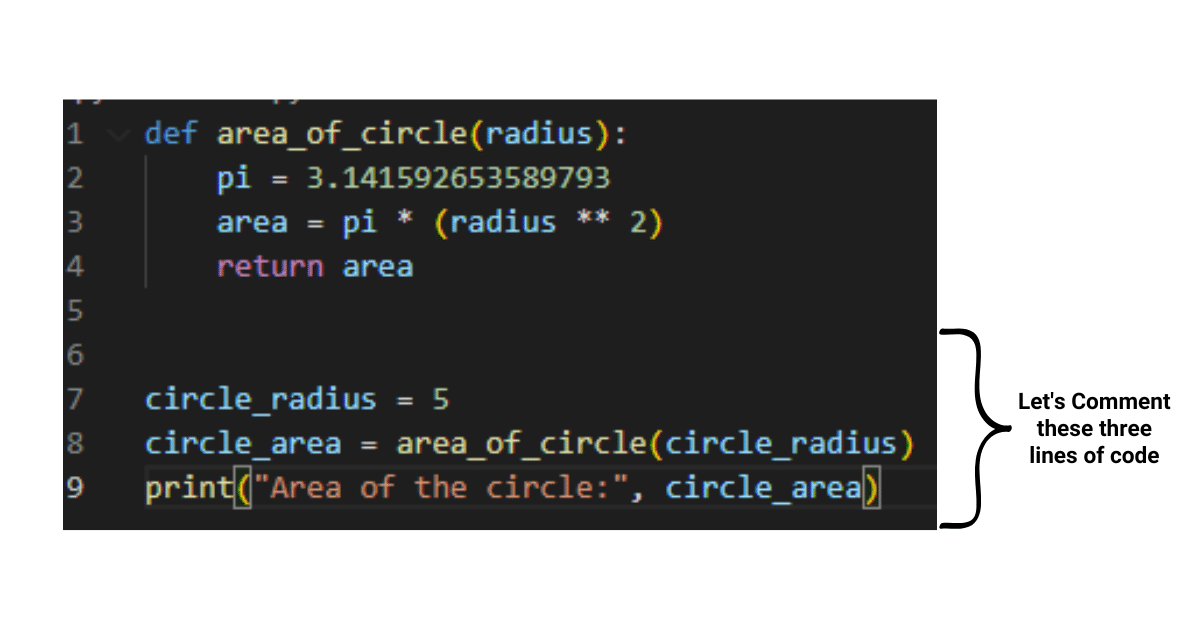
Press Ctrl + / on Windows or Command + / on Mac to toggle line comments.
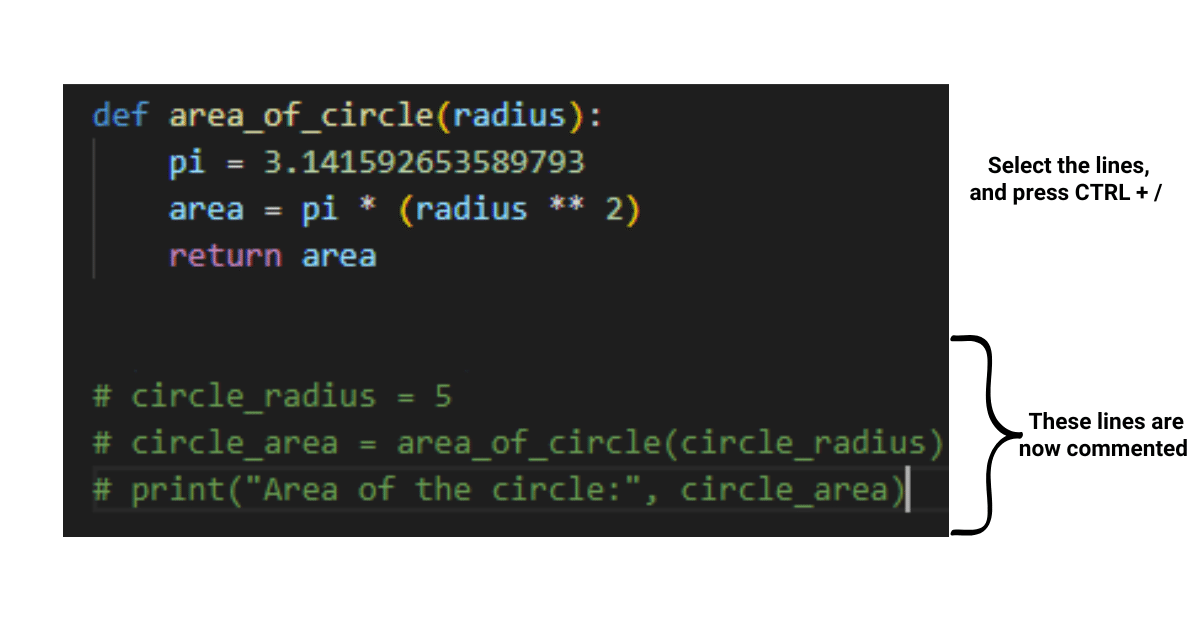
Alternatively, you can press Shift + Alt + A to toggle block comments.
Now that you have an understanding of how to comment out multiple lines in VS Code, you can go ahead and use it in your Python program.
The section below shows how to comment out multiple lines in PyCharm.
Let’s get into it!
How to Comment Out Multiple Lines in PyCharm, 3 Simple Steps
PyCharm is a popular Integrated Development Environment (IDE) developed by JetBrains specifically for Python development. It provides a comprehensive set of tools and features that streamline the development process and improve productivity.
PyCharm supports commenting out multiple lines of code. Commenting out multiple lines of code in PyCharm is similar to that in VS Code.
Here’s how to do it:
Select the lines of code you want to comment out.
Press Ctrl + / on Windows or Command + / on Mac to toggle line comments.
Alternatively, you can press Ctrl + Shift + / to toggle block comments.
How to Comment Out Multiple Lines in Sublime Text, 3 Simple Steps
Sublime Text is a sophisticated and lightweight text editor designed for code, markup, and prose. It is known for its speed, ease of use, and flexibility, making it a popular choice among developers working with various programming languages, including Python, JavaScript, HTML, CSS, and many others.
Sublime Text also supports commenting out multiple lines of code. Here’s how to do it:
Select the lines of code you want to comment out.
Press Ctrl + / on Windows or Command + / on Mac to toggle line comments.
Alternatively, you can press Ctrl + Shift + / to toggle block comments.
Utilizing a code editor or an integrated development environment (IDE) like Visual Studio Code, PyCharm, or Sublime Text to comment out multiple lines of code in Python or other programming languages can be a significant time-saver and improve your overall development efficiency.
This straightforward and powerful approach allows developers to rapidly comment out or uncomment substantial blocks of code, bypassing the need to tediously add or remove comment symbols, such as single line comments (#) or multi-line comments (triple quotes), on every individual line.
Popular code editors often come with built-in features or keyboard shortcuts that make commenting out multiple lines, including consecutive single line comments or multiline comments, a breeze.
Furthermore, some editors provide third-party extensions or plugins that enhance this functionality, making it even easier to manage large sections of code that require temporary disabling or annotation.
By harnessing these tools and mastering the techniques of commenting out multiple lines using code editors, you can save a considerable amount of time and effort, ensuring a more enjoyable and efficient coding experience.
How to Comment Out Multiple Lines Using Python IDLE
Python’s Integrated Development and Learning Environment (IDLE) provides a handy feature to quickly comment out multiple lines of code. Here’s how you can do it:
- First, open the Python file that you want to edit in IDLE.
- Select the lines of code that you want to comment out.
- Use the keyboard shortcut Ctrl + / (for Windows) or Cmd + / (for Mac) to comment out the selected lines. If you’re using a numeric keypad, you can also use *Ctrl + Num/ **(for Windows) or *Cmd + Num/ **(for Mac).
- If you want to uncomment the lines later, just select the commented lines and use the same keyboard shortcut to toggle the comments.
- Save your changes by pressing Ctrl + S (for Windows) or Cmd + S (for Mac).
Remember that using the keyboard shortcut to comment out lines of code is a toggle operation. If you have a mix of commented and uncommented lines in your selection, it will uncomment the commented lines and vice versa.
Benefits of Commenting Out Multiple Lines

In this section, we’ll discuss some of the advantages of commenting out multiple lines of code. Commenting out code can be useful for several reasons:
- Testing and debugging: When you encounter an error in your code, you may need to test different parts of your program to identify the issue. By commenting out large sections of code, you can quickly isolate the problematic code and focus on debugging it.
- Version control: When working on a project with multiple collaborators, or when maintaining a large codebase, you may need to keep track of different versions of your code. By commenting out code instead of deleting it, you can easily revert to a previous version if needed.
- Documentation: Commenting out code can serve as a form of documentation. It allows you to provide explanations or notes about specific parts of your program, making it easier for other developers (or even yourself in the future) to understand the code’s purpose or functionality.
- Experimental code: Sometimes, you may want to try out different approaches or algorithms in your code. By commenting out alternative solutions, you can keep them in your codebase for future reference, without them affecting the current behavior of your program.
- Temporary code removal: If you need to temporarily remove a section of your code without deleting it, commenting it out is an excellent way to do so. This can be helpful when you’re working on a specific feature or fixing a bug, and you want to maintain a clean, organized codebase.
- Avoiding redundancy: Commenting out code can help you avoid redundancy in your codebase. Instead of deleting code that you might need later, you can simply comment it out. This approach saves time and ensures that you have a record of all the code you’ve written.
- Collaboration: Commenting out code can improve collaboration with other developers. When working on a team project, you may need to share your code with others. By commenting out code instead of deleting it, you make it easier for your team members to understand the changes you’ve made.
- Code organization: Commenting out code can improve the organization of your codebase. By commenting out unused or old code, you can focus on the essential parts of your program, making it easier to read, understand, and maintain.
- Code comparison: Commenting out code can make it easier to compare different versions of your code. When you comment out code instead of deleting it, you create a history of your code changes. This history can be valuable when you need to compare different versions of your program or understand how it has evolved over time.
In summary, commenting out code is a powerful technique that offers many benefits, including making your code more manageable, facilitating collaboration, and providing a useful form of documentation. By using this technique judiciously, you can write cleaner, more maintainable code that is easier to understand and work with.
Why Use a Multiline Comment in Python code?
Commenting out multiple lines in Python helps with fixing bugs, explaining code, tracking changes, and testing.
Code explanation: Multiline comments allow developers to provide detailed explanations, descriptions, or documentation strings for specific sections of the code, enhancing readability and maintainability.
The code example shows how you can use miltiline or block comments in Python to explain your code:
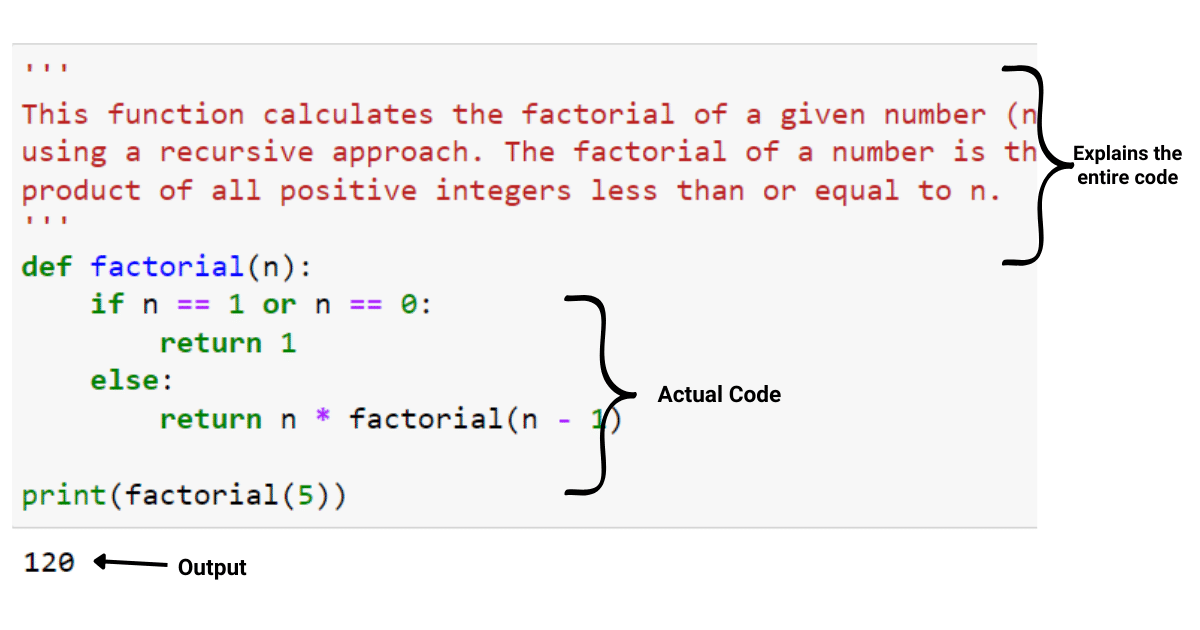
Debugging: When debugging or troubleshooting, multi-line comments can be used to temporarily disable a block of code to identify and isolate issues without deleting the code.
The code example below shows how you can use multiline comments to debug your code:
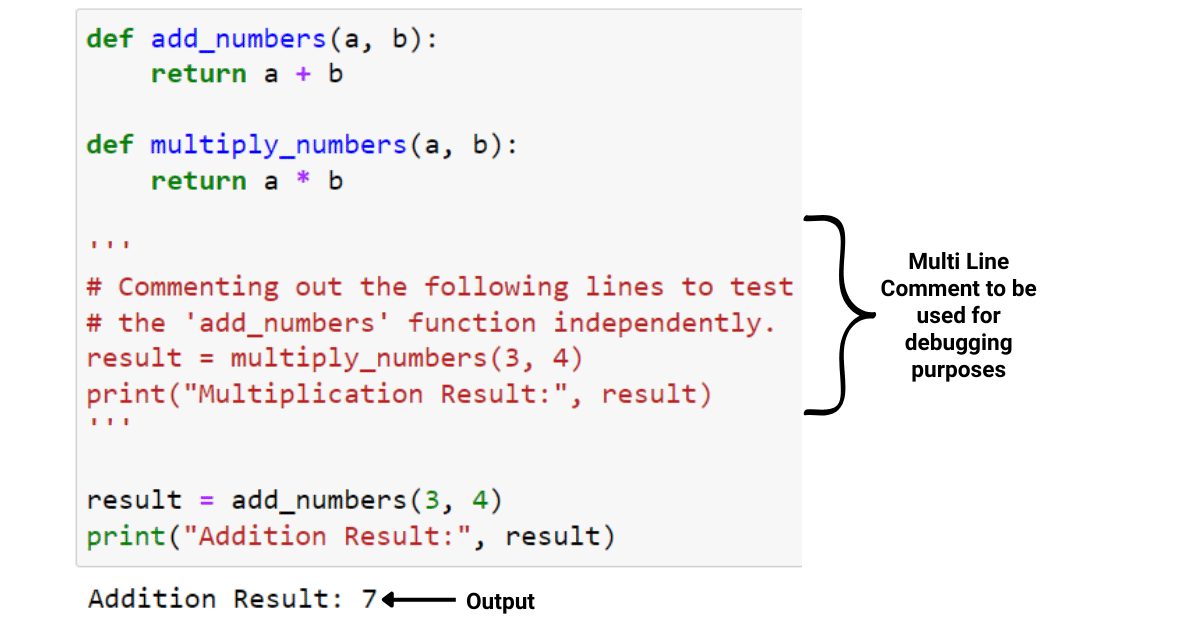
Code organization: Multiline comments can be employed to separate different parts of the code, making it easier to understand the structure and organization of the program.
The code example below shows how you can use a multiline comment to organize your code.
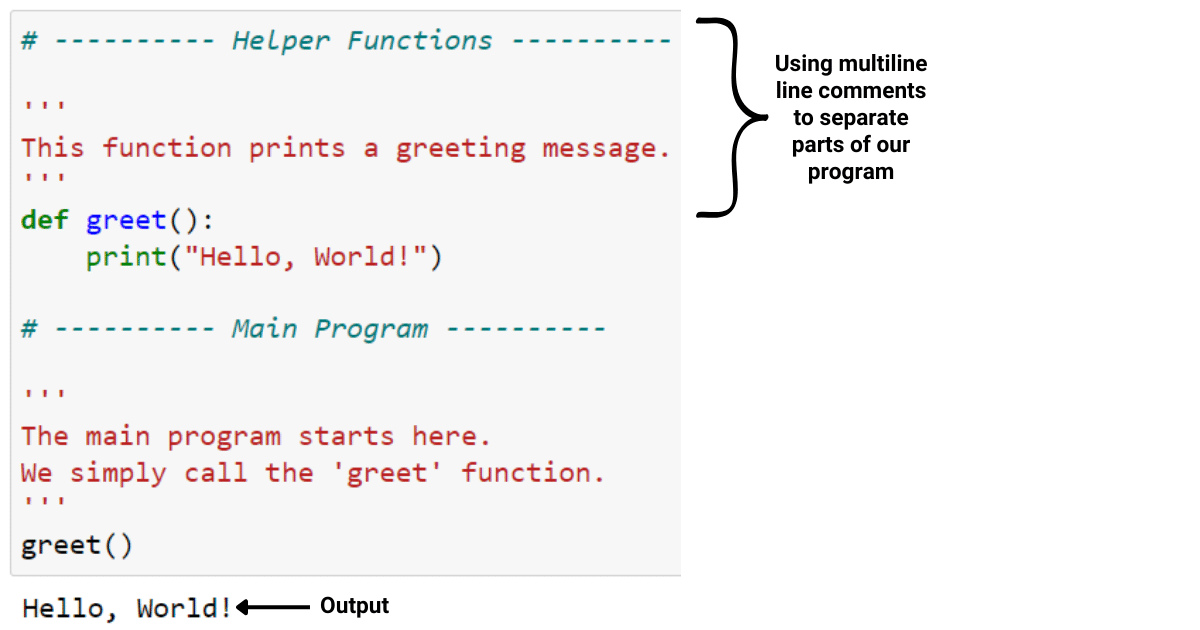
Collaboration: Providing comprehensive comments within the code helps other developers comprehend the code’s purpose or functionality, fostering better collaboration and communication within the team.
The code example below shows how you can use multiline comments to enhance collaboration:
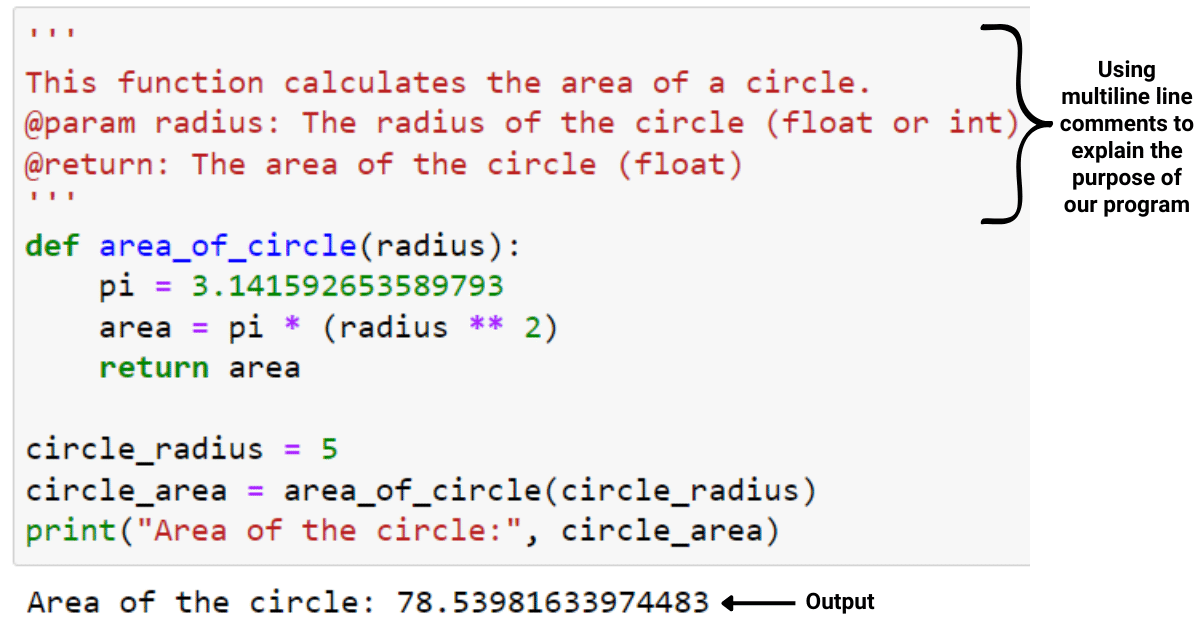
For a more detailed explanation of using comments and avoiding errors in your Python code, take a look at the video below.
Now that we’ve established that comments are an essential part of any Python code, let’s look at some of the best practices that will help you write better comments when coding.
Best Practices for Multiline Commenting in Python
As you know understand, multiline commenting in Python can improve the readability of your code and help explain complex logic, algorithms, or code blocks.
Here are some best practices for multi-line commenting in Python:
Provide a clear description: When writing multi-line comments, make sure to provide a clear and concise description of the purpose of the code block, function, or algorithm. Your goal is to help others understand the intent and functionality of the code without having to decipher it themselves.
Explain complex logic: If your code contains complex algorithms or intricate logic, use multi-line comments to clarify how the code works and why it was implemented in that particular way. This will make it easier for others to understand and maintain your code.
Separate paragraphs for readability: When writing longer multi-line comments, consider separating paragraphs with blank lines. This improves the readability of your comments, making it easier for others to grasp the information quickly.
Use indentation: Maintain proper indentation within multi-line comments to match the indentation level of the surrounding code. This helps maintain the visual structure of your code and makes it easier to read and understand.
Avoid excessive commenting: While multi-line comments can be useful for providing detailed explanations or descriptions, avoid overusing them. Only use multi-line comments when necessary, and keep them concise and focused on providing valuable context or explanation.
Final Thoughts

In Python, commenting out multiple lines of code is an important skill to learn. It allows you to quickly test different parts of your code, keep old code for future reference, and provide clear explanations to other developers.
In this article, we’ve explored two methods for commenting out multiple lines of code: using triple quotes and using Python IDLE. We’ve also covered the benefits of commenting out code and why it’s important to use this technique in your Python projects.
Mastering the art of commenting out multiple lines will undoubtedly make your coding journey smoother, more efficient, and more enjoyable. By integrating this technique into your coding process, you’ll be better equipped to write clean, readable, and well-documented code in Python.
In conclusion, commenting out multiple lines in Python can be achieved through various methods, each with its own advantages.
Here’s a summary:
Conventional method: Use the hash symbol (#) at the beginning of each line. This approach is straightforward and widely used by Python programmers.
Alternative method (not recommended): Use triple quotes (”’ ”’ or “”” “””) to create multi-line strings. Avoid this method as it can cause side effects in your code.
Additionally, utilizing keyboard shortcuts in text editors can save time and effort. Here are some common shortcuts:
Visual Studio: Ctrl + K, Ctrl + C
Spyder IDE: Ctrl + 1
IDLE: Alt + 4
Jupyter Notebook: Ctrl + /
PyCharm: Ctrl + Shift + /
You should choose the method that best suits your needs and project. Always prioritize keeping your code organized and easy to read for improved comprehension and maintainability.
Frequently Asked Questions
What is the purpose of commenting out multiple lines in Python?
Commenting out multiple lines in Python allows you to temporarily disable a block of code without deleting it. This is useful during testing, debugging, or when you want to keep code for future reference without executing it.
How do I comment out a single line of code in Python?
To comment out a single line of code in Python, use the hash symbol (#) at the beginning of the line. The interpreter will ignore everything after the hash symbol on that line.
How to comment out code in a Python script?
In Python, you can use the # character to comment out a single line of code. To comment out multiple lines, you can use triple quotes (”’).
How to use multiple comments in Python?
To comment out multiple lines of code in Python, you can use either the # character or triple quotes (”’).
What is the shortcut to comment multiple lines in Python?
In most code editors, including PyCharm, Visual Studio Code, and Sublime Text, you can use the Ctrl+/ shortcut to comment out multiple lines of code.
How to comment out a block of code in PyCharm?
In PyCharm, you can use the # character to comment out a single line of code. To comment out multiple lines, you can select the code block and use the Ctrl+/ shortcut.
What is the hotkey for commenting out code in Visual Studio Code?
In Visual Studio Code, you can use the Ctrl+/ shortcut to comment out multiple lines of code.
How to toggle comment in Jupyter Notebook?
In Jupyter Notebook, you can use the Ctrl+/ shortcut to toggle comments for the selected code block.
What are the two ways to comment out multiple lines in Python?
You can comment out multiple lines in Python using either multiline strings (triple quotes) or by placing a hash symbol (#) at the beginning of each line you want to comment out.
Can I use triple quotes to comment out a mixture of code and text in Python?
Yes, you can use triple quotes to comment out a mixture of code and text in Python. The interpreter will treat everything between the opening and closing triple quotes as a single multiline string, effectively disabling the code within.
How do I uncomment multiple lines in Python?
To uncomment multiple lines in Python, remove the triple quotes surrounding the commented block, or delete the hash symbols (#) at the beginning of each commented line.
Do comments affect the performance of my Python code?
No, comments do not affect the performance of your Python code. The interpreter ignores comments during code execution, so they have no impact on the speed or efficiency of your program.
Is it possible to nest comments in Python?
Python does not support nested comments. When using triple quotes to comment out a block of code, any triple quotes within the block will be treated as part of the multiline string and not as nested comments.
What are some best practices for commenting in Python?
Some best practices for commenting in Python include:
Use comments to provide context, and explanations, or to clarify complex code.
Keep comments concise and relevant.
Update comments as you modify the code to ensure they remain accurate.
Use single-line comments for brief explanations and multiline comments for more detailed descriptions or to disable blocks of code.








